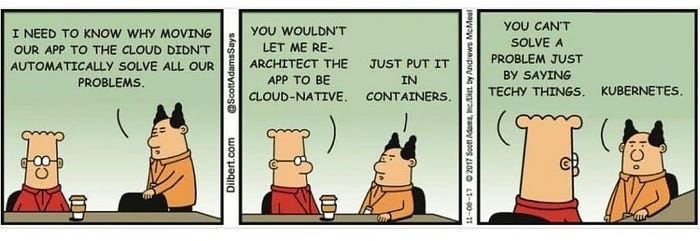The Great Kubernetes Debate

@petecheslock took to Twitter to voice a critical perspective on the ubiquitous Kubernetes technology:
This tweet stirred up a storm of responses and brought to the fore a pivotal question: Does your organization really need Kubernetes?
Part 1: How We Got Here
The journey to Kubernetes begins with understanding the transition from monolithic to microservices architectures and the problems this shift aimed to solve.
From Monoliths to Microservices
In the early days of software development, monolithic architectures were the norm. These are large, unified codebases where all the application's logic is tightly coupled and run as a single service. While this approach has its advantages in terms of simplicity and straightforwardness, it also has significant downsides, especially as applications grow in size and complexity.
To address these challenges, the industry gradually moved towards a microservices architecture, where an application is divided into smaller, loosely coupled services. Each microservice can be developed, deployed, and scaled independently, offering greater flexibility and resilience.
However, this new architecture introduced its own set of challenges. As the number of services grew, developers had to figure out how to manage them efficiently. This included tasks like scaling, deployment, networking, and fault tolerance.
Cloud Computing and Openstack
Virtual machines (VMs) were one of the early solutions adopted to handle these challenges. By allowing multiple operating systems to run on a single physical machine, VMs offered a way to isolate different applications and make better use of hardware resources.
Then came the era of cloud computing platforms, with OpenStack being one of the pioneers. Introduced in 2010, OpenStack provided a way to manage large pools of compute, storage, and networking resources in a data center, effectively offering "Infrastructure as a Service." However, OpenStack was infamous for its complexity and steep learning curve, making it a challenging tool for many organizations to adopt. It still works for some use cases, but never really got the adoption everybody was predicting it to.
The Need for Container Orchestration
In parallel with these developments, the concept of containerization started to gain traction. Docker, introduced in 2013, was a game-changer in this space. Docker made it easy to package and distribute software in containers, lightweight standalone packages that contain everything needed to run an application.
While Docker was instrumental in the adoption of microservices, it didn't provide a solution to orchestrate and manage these containers at scale. Docker's own native clustering and scheduling tool, Docker Swarm, while simple to use, lacked the advanced features and flexibility desired by larger, more complex deployments.
Another early player in the container orchestration space was Apache Mesos, designed for data center management, which could handle both containerized and non-containerized workloads. However, Mesos, although powerful, had a steep learning curve and was often seen as overkill for simpler use cases.
The stage was set for a tool that could bridge the gap – provide the power and flexibility needed to manage complex microservices architectures, but without the steep learning curve. Kubernetes, first released by Google in 2014, emerged as a robust, open-source platform that could orchestrate and manage containers at scale. By providing a consistent environment for deployment, scaling, and operations of application containers across clusters of hosts, Kubernetes proved to be the solution that many organizations were seeking.
Part 2: The Benefits of Kubernetes
Now that we've traced the origins of Kubernetes, let's dive into what makes Kubernetes so appealing to organizations worldwide.
Enhanced Developer Productivity - Kubernetes can speed up the software development process by automating many manual tasks. It provides out-of-the-box solutions for deployment, scaling, and management of applications, freeing developers to focus on writing code rather than managing infrastructure.
Scalability - One of the key selling points of Kubernetes is its ability to handle scaling automatically. The Kubernetes scheduler can distribute workloads efficiently across a cluster, ensuring that each container has enough resources to run effectively. It can also scale applications up or down based on demand, ensuring optimal resource usage.
High Availability - Kubernetes is designed to keep applications running without any downtime. It provides built-in mechanisms for self-healing, which means it can automatically replace and reschedule containers when a node fails. It can also distribute containers among nodes to ensure workloads are not impacted by a single point of failure.
Portability - Kubernetes runs on almost any platform that supports containers, including public clouds, private clouds, and on-premises servers. This makes it an excellent choice for companies looking for a hybrid cloud or multi-cloud strategy.
Part 3: The Challenges of Kubernetes
While Kubernetes offers powerful features and flexibility, it is not without its challenges. It's important for organizations to understand these before making the decision to adopt Kubernetes.
Complexity - Kubernetes is notoriously complex to set up and manage. It has a steep learning curve, requiring a deep understanding of its concepts and components to use effectively. This especially affects the on-prem environments, where you have to go full DIY to adopt Kubernetes.
Cost - The financial implications of running a Kubernetes cluster can be significant. While the software itself is free and open-source, the costs associated with the necessary hardware, cloud services, and employee training can add up. Furthermore, maintaining and operating a Kubernetes cluster can (and will) require a dedicated team, which means additional personnel costs.
Over-Engineering - Kubernetes is a powerful tool, but it may be overkill for small projects or teams. For organizations with simpler use cases, adopting Kubernetes can lead to unnecessary complexity and resource usage. Some workloads might be more efficiently run on traditional VMs, or using simpler container management solutions.
Security - While Kubernetes provides some built-in security features, it also introduces new potential attack vectors. Managing the security of a Kubernetes cluster requires constant vigilance and a good understanding of best practices.
Maintenance - Maintaining and upgrading a Kubernetes cluster can be challenging, especially for organizations with limited technical resources. This includes tasks like patching, upgrading, and scaling the cluster, as well as monitoring and troubleshooting issues that arise. Many teams are stuck in the outdated releases due to this.
Need more proof? Checkout Kubernetes Failure Stories on how complex the Kubernetes maintenance is from teams that already use it.
Part 4: Making the Decision
When deciding whether or not to adopt Kubernetes, there are several considerations for organizational leaders.
Assess Your Needs
Understanding your organization's specific needs and constraints is the first step. What problems are you trying to solve? Are you managing a large number of microservices? Are you seeking better ways to scale your applications? Are you having lots of infrastructure reliability issues? Or is your interest in Kubernetes driven by industry trends (a.k.a Resume Driven Development)?
Remember, Kubernetes is a tool, not a goal in itself. It is only as valuable as it helps you achieve your business objectives. It's essential to avoid adopting Kubernetes (or any technology) simply because it's the "new and shiny" thing and everybody else does it. The technology you choose should serve your business needs effectively and efficiently.
Consider Your Resources
Next, evaluate the resources you have at your disposal. Do you have the necessary technical expertise in-house to manage a Kubernetes cluster? Do you have resources to build platforms on top of k8s? If not, are you willing and able to invest in training or hiring?
Financial resources are another factor to consider. While Kubernetes itself is free, there can be significant costs associated with infrastructure, personnel, and operations. In addition, you would have to enhance k8s with additional sauce like monitoring and alerting, CI/CD platform, etc - which might require buying appropriate solutions from different vendors.
Evaluate Alternatives
Before jumping onto the Kubernetes bandwagon, take the time to evaluate alternatives. Do you already have the system that’s working and scaling for your needs? Depending on your requirements, a simpler container orchestration tool, a Platform as a Service, or even traditional virtual machines may be a better fit.
Some options to consider:
Google Cloud Run
AWS ECS
Azure Containers
Heroku
DigitalOceal App Platform
Render
What's Your Cloud Strategy?
Your cloud strategy plays a critical role in the Kubernetes decision. For organizations running applications in the cloud, managed Kubernetes services like GKE, EKS, or AKS may be a good fit. These services handle much of the Kubernetes setup and management, freeing up your team to focus on application development.
However, if you have strict compliance or security requirements, or if you simply prefer to have more control over your infrastructure, an on-premises Kubernetes setup might be a better choice. Keep in mind that this approach requires much more effort and resources to manage.
Assess Your Scale Needs
It's important to evaluate or consider current and future the scale of your organization's operations, applications, and infrastructure. This involves thoroughly assessing the size and complexity of your applications and determining if you are managing a large number of microservices or if significant scalability is required.
Conclusion
In conclusion, Kubernetes is a powerful tool that can bring significant benefits, but it's not a one-size-fits-all solution. Like any technology decision, adopting Kubernetes should be a strategic choice based on careful evaluation of your organization's needs, resources, and alternatives.
As the saying goes, "Choose the right tool for the job," and Kubernetes might or might not be that tool for your organization.
In the end, it's not about whether Kubernetes is good or bad, but whether it's the right fit for your organization's unique context.
Enjoyed the read? Then you're gonna love our newsletter. It’s like a tech conference, but without the awkward networking. It's free, so subscribe today!






